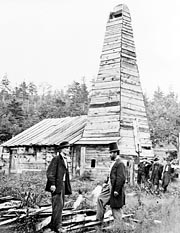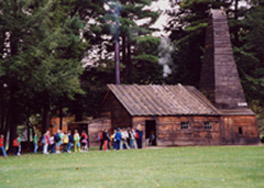
To be specific, the industry's precise place of origin is at the present day Drake Well Museum, Titusville, Pa. On the museum's 219-acre grounds is "the site of Edwin Drake's well, which was the first well drilled specifically for petroleum, which resulted in commercial success in 1859," museum director Barbara Zolli explains. "There are other wells in the country that are older, but many of them were salt wells where oil or petroleum was a byproduct."
Zolli says that Drake's well sparked off what could essentially be referred to as the Black Gold Rush. "It pretty much went through the Oil Creek Valley, and wells came in that were much more productive than his as people mastered the industry," she explains. "The heyday for the Valley here was pretty much between 1859 and the 1870s or so."

Like many of the boomtowns, though, Pithole's life was fleeting. Shortly after being incorporated with a burrow charter in 1865, "the wells that were drilled very close together began to fail, and the community suffered a lot of very serious fires and people began to move on," Zolli describes. Ultimately, the city had its charter rescinded in 1867.
There is no longer anyone living in Pithole, and little remains of the boomtown but grassy streets and cellar holes. However, to remind folks of the community's brief greatness, the museum manages and maintains a 92-acre satellite site on the city's remains. At the Pithole Visitors' Center, guests can examine a scale model of the boomtown at its 1866 peak, and they also can walk the streets of the ghost town to get a feel of Pithole's eerie come-and-go success.
While Pithole City certainly is worth checking out, the Valley's historical gem is the Drake Well Museum. Zolli says approximately 50,000 people a year tread on the museum's grounds, either to visit the exhibits or to take advantage of the abundant recreational opportunities -- such as picnicking, fishing, biking and hiking -- that are available onsite. "We also work very closely with the schools in the community," she reports. "We have a youth docent program, where fifth graders in the region come here, learn history from the point of view of the children of the time period and often represent the children of famous people. After coming here, they do the research, they write a script, they develop a costume and then they audition. The ones who have been here the longest are now second and third year in college, but they started as fifth graders. We have 13 current fifth graders who are costumed docents, and generally they are here on weekends. They also do outreach programs and performances in the community."

There are historical buildings are on site, as well. For example, some historical pumping stations have been moved to the museum, Zolli says, like the "Silver Run Pump Station, which was on the National Transit Line, originally owned by the Standard Oil Co. It is probably 125 years old." And, of course, the museum wouldn't be complete without its focal point: a board-for-board copy of Drake's original engine house and derrick. The Drake Well is pumped during the summer seasons, but the oil is recirculated.
To see oil actually being pumped, visitors need to head over to nearby McClintock Well #1. According to Zolli, it "is the oldest well in continuous production in the world, and it dates from 1861. We pump that approximately four times a year and sell the oil in souvenir bottles. We make considerably more than the $30 a barrel that our local independent producers would appreciate."
All three of these sites offer rare and valuable information about the history of oil drilling. If you're in northwestern Pennsylvania, it would be well worth it to load up the kids and pay a visit to the birthplace of the modern-day industry. You're sure to leave with a better appreciation of how far drilling has come since Drake first struck oil 143 years ago.
For more information on the Drake Well Museum, call 814-827-2797 or visit www.drakewell.org.
Report Abusive Comment